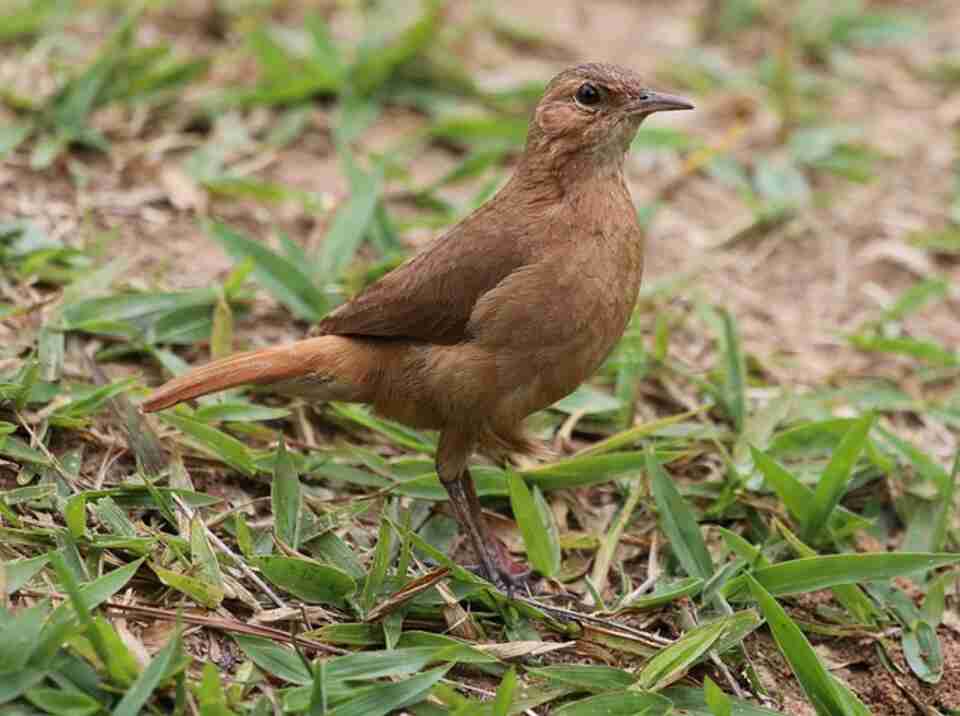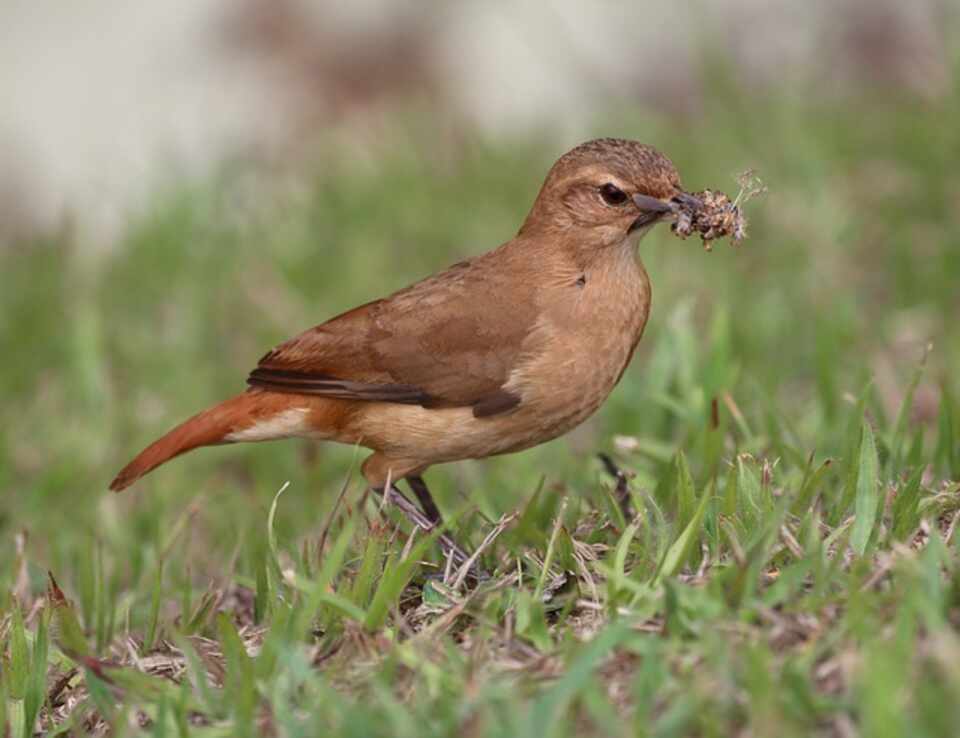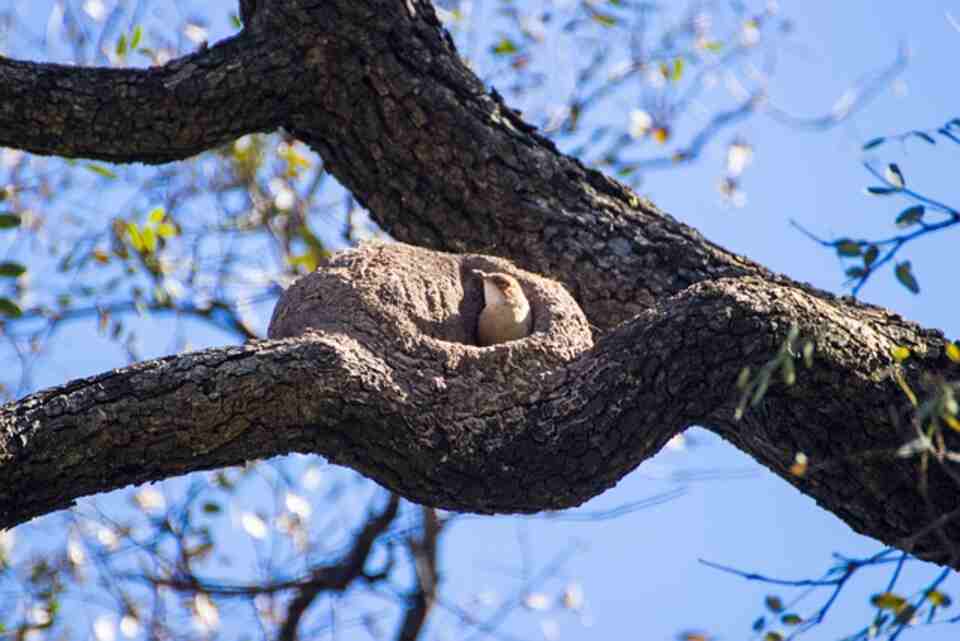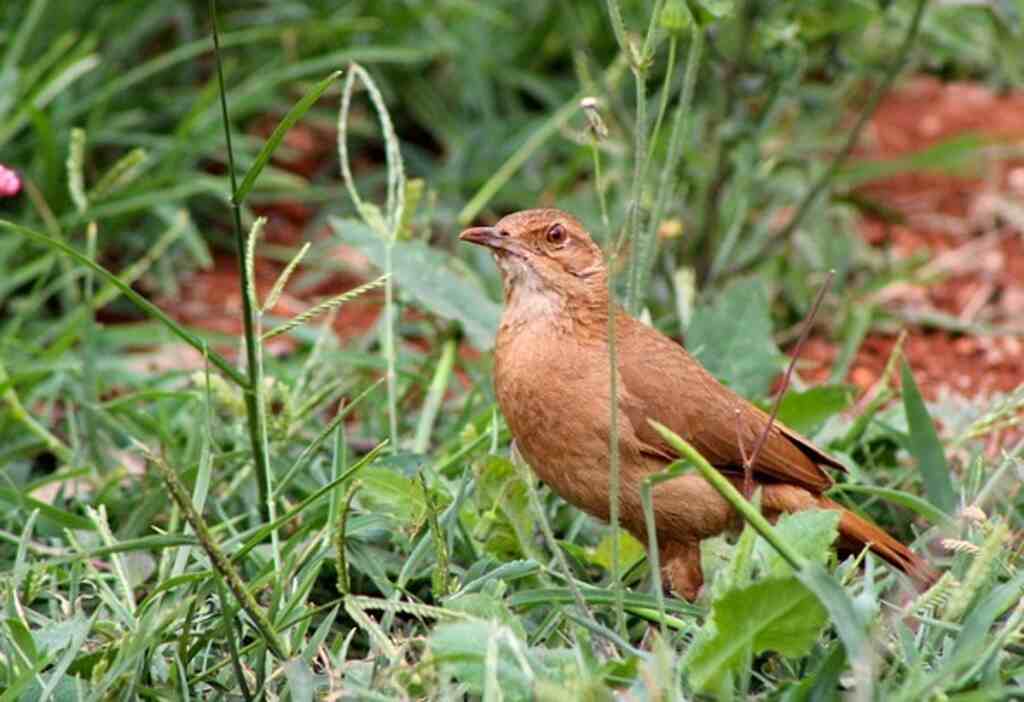Hello and welcome! Today, I’m thrilled to embark on a captivating exploration of the Rufous Hornero, a remarkable avian figure that proudly represents Argentina as its national symbol. Come along as we unravel the significance of this bird and delve into its profound cultural importance in the vibrant tapestry of Argentina.
The Rufous Hornero holds a special place in the hearts of the Argentinian people. With its unique mud nests and resilient nature, this bird symbolizes hard work and perseverance, reflecting the spirit of the nation. As a native species, the Rufous Hornero has become deeply ingrained in the cultural identity of Argentina.
From its reddish-brown plumage to its intricate nest-building skills, the Rufous Hornero captivates the imagination. Join me as we uncover the symbolism behind Argentina’s national bird and learn about its appearance, habitat, and significance.
Table of Contents
- 1 Key Takeaways:
- 2 Which Bird Is the National Symbol of Argentina?
- 3 What Does the National Bird of Argentina Symbolize?
- 4 National Avian Emblem of Argentina: The Rufous Hornero
- 5 Where Do Rufous Hornero Live?
- 6 Significance of the Rufous Hornero in Argentina
- 7 Conservation Efforts for the Rufous Hornero
- 8 The Andean Condor as Argentina’s National Symbol
- 9 Conservation Efforts for the Andean Condor
- 10 Conclusion
- 11 FAQs:
- 11.1 What bird is the national symbol of Argentina?
- 11.2 What does the national bird of Argentina symbolize?
- 11.3 What does a Rufous Hornero look like?
- 11.4 Where do Rufous Hornero live?
- 11.5 What is the significance of the Rufous Hornero?
- 11.6 What conservation efforts are in place for the Rufous Hornero?
- 11.7 Is the Andean Condor the national bird of Argentina?
- 11.8 What conservation efforts are in place for the Andean Condor?
- 12 Source Links
- 13 Author
Key Takeaways:
- The Rufous Hornero is the national symbol of Argentina, representing hard work and perseverance.
- It has a unique appearance with reddish-brown plumage and distinctive mud nests.
- The bird thrives in various environments across Argentina and neighboring countries.
- The Rufous Hornero symbolizes the adaptability and resilience of the Argentinian people.
- Efforts are being made to conserve and protect the Rufous Hornero and its habitat.

Which Bird Is the National Symbol of Argentina?
The Rufous Hornero is the national bird of Argentina, representing the country’s spirit and identity. Known for its reddish-brown plumage, distinctive mud nests, and hardworking nature, the Rufous Hornero holds immense cultural significance in Argentina.
The selection of the Rufous Hornero as the national bird reflects Argentina’s deep connection to nature and its appreciation for the bird’s unique characteristics. As a national emblem, the Rufous Hornero is proudly depicted on the Argentine coat of arms, further reinforcing its symbolic importance.
The Rufous Hornero: A Symbol of Diligence and Unity
The Rufous Hornero’s representation as the national bird of Argentina is deeply rooted in its symbolism. The bird embodies the spirit of hard work and perseverance, traits that are highly valued in Argentine culture. The Rufous Hornero’s dedication to building intricate mud nests showcases its diligence and the power of collaboration, as pairs of birds work together to construct their homes.
The national bird also represents unity, reflecting the diverse ecosystems and cultural heritage found across Argentina. The Rufous Hornero can be observed thriving in various environments, including savannas, scrublands, and even urban areas. Its adaptability and resilience mirror the country’s ability to embrace diversity and overcome challenges.
| Rufous Hornero | ||
|---|---|---|
| Scientific Name | Furnarius rufus | |
| Plumage | Reddish-brown | |
| Habitat | Savannas, scrublands, urban areas | |
| Symbolism | Hard work, perseverance, unity |
The Rufous Hornero’s presence as the national bird of Argentina serves as a constant reminder of the country’s dedication to preserving its natural heritage and fostering a sense of unity among its people.
Conservation efforts are underway to protect the bird’s habitat and raise awareness about its ecological importance, ensuring that future generations can continue to admire and appreciate this beloved national symbol.
What Does the National Bird of Argentina Symbolize?
The Rufous Hornero, as the national bird of Argentina, holds deep symbolism and represents various aspects of the country’s identity. Its significance goes beyond its physical appearance and extends to cultural values and national spirit. The symbol of the Rufous Hornero reflects the unique attributes that resonate with the Argentine people.
Symbolism of Argentina’s national bird:
The Rufous Hornero symbolizes hard work, perseverance, and unity. This bird is known for its dedication to building intricate mud nests, symbolizing the diligent nature of the Argentinian people. The construction of these nests requires collective effort, portraying the importance of collaboration and unity in the country’s cultural fabric.
The Rufous Hornero’s adaptability and resilience are reflected in its thriving presence across diverse environments in Argentina. It represents the ability to overcome challenges and adapt to changing circumstances, mirroring the resilience and resourcefulness of the Argentinian population.
Significance of the national bird in Argentina:
Argentina’s avian national identity is deeply rooted in the Rufous Hornero. The bird embodies the country’s rich biodiversity and serves as a reminder of the value placed on nature. It holds a place of honor on the Argentine coat of arms, symbolizing its importance in protecting and upholding the nation’s values.
Symbolic importance of the national bird in Argentina:
The Rufous Hornero is a source of pride and admiration for the Argentinian people. It represents their cultural heritage, natural beauty, and the spirit of the nation. Its symbolic importance reinforces the commitment to preserving Argentina’s avian national identity and conserving the bird’s habitat for future generations.
The Symbolism of the Rufous Hornero
| Symbolism | Meaning |
|---|---|
| Hard Work | Reflects the diligent nature of the Argentinian people |
| Perseverance | Symbolizes the ability to overcome challenges and adapt to changing circumstances |
| Unity | Represents the importance of collaboration and unity in the country’s cultural fabric |
| Adaptability | Mirrors the resilience and resourcefulness of the Argentinian population |
| Rich Biodiversity | Serves as a reminder of the value placed on nature and the country’s diverse ecosystems |
National Avian Emblem of Argentina: The Rufous Hornero
The Rufous Hornero, with its distinct appearance and symbolic significance, proudly represents Argentina as its national bird. This avian emblem showcases the country’s rich cultural heritage, biodiversity, and the values it holds dear – diligence, unity, and adaptability. With its reddish-brown plumage and intricate mud nests, the Rufous Hornero captures the essence of Argentina’s avian national identity.
The Rufous Hornero is a medium-sized bird that can be easily recognized by its unique features. Both male and female Horneros share similar coloration, emphasizing gender equality and inclusivity. They have prominent black eyes that exude intelligence and curiosity, while their long bills and square-tailed feathers add to their distinctive appearance.
Table: Comparing the Rufous Hornero and the Andean Condor
| Characteristics | Rufous Hornero | Andean Condor |
|---|---|---|
| Plumage Color | Reddish-brown | Black and white |
| Wingspan | Approximately 30 cm | Approximately 3 meters |
| Habitat | Various environments, including urban areas | Mountainous regions and cliffs |
| Symbolic Representation | Hard work, unity, and adaptability | Power, freedom, and cultural significance |
“The Rufous Hornero and the Andean Condor are both significant avian symbols in Argentina, each representing a unique facet of our nation’s identity,” states Eduardo Lopez, an ornithologist in Argentina.
“While the Rufous Hornero embodies the values of hard work and resilience, the Andean Condor is a powerful symbol of our cultural heritage and the untamed beauty of our landscapes.”
Together, these birds contribute to the vibrant tapestry that makes Argentina’s avian emblem so remarkable.
As Argentina continues to celebrate and protect its avian heritage, the Rufous Hornero remains a cherished national symbol, inspiring the Argentinian people to embrace their cultural roots and safeguard the natural world for future generations.

Where Do Rufous Hornero Live?
The Rufous Hornero, Argentina’s national bird and avian representation, inhabits not only Argentina but also neighboring countries such as Uruguay, Bolivia, and Paraguay. This bird species can adapt to various environments, showcasing the versatility and resilience of the Argentinian people and their multifaceted cultural identity.
Thriving in habitats like savannas, second-growth scrub, pastures, and even urban areas, the Rufous Hornero embodies the spirit of Argentina’s diverse landscapes. Its ability to build nests in different environments reflects the resourcefulness and adaptability that define the nation.
Whether you’re exploring the grassy plains of Argentina’s pampas or wandering through the bustling streets of Buenos Aires, chances are you’ll encounter the Rufous Hornero, a symbolic reminder of Argentina’s rich natural heritage and cultural tapestry.
| Habitat | Distribution |
|---|---|
| Savannas | Argentina, Uruguay, Bolivia, Paraguay |
| Second-growth scrub | Argentina, Uruguay, Bolivia, Paraguay |
| Pastures | Argentina, Uruguay, Bolivia, Paraguay |
| Urban areas | Argentina, Uruguay, Bolivia, Paraguay |
Significance of the Rufous Hornero in Argentina
The Rufous Hornero holds immense significance in Argentina, representing the country’s rich biodiversity and cultural tapestry. As the national bird and emblematic symbol, it embodies the values and spirit of the Argentinian people.
The bird’s unique nest-building skills symbolize diligence and collaboration, reflecting the hardworking nature and unity of the nation. Each meticulously crafted mud nest serves as a testament to the Rufous Hornero’s dedication and perseverance, inspiring the Argentinian people to strive for excellence in their endeavors.
A quote from an Argentinian conservationist: “The Rufous Hornero is not only a bird; it is a symbol of our heritage and resilience. Its presence reminds us of the importance of protecting our natural resources and working together to safeguard our cultural identity.”
The Rufous Hornero’s position on the Argentine coat of arms further emphasizes its role in protecting and safeguarding the nation. This prominent placement highlights the bird’s significance and showcases its importance in representing Argentina’s identity both nationally and internationally.
Table: The Symbolic Significance of the Rufous Hornero
| Symbolic Meaning | Explanation |
|---|---|
| Hard work | The Rufous Hornero’s dedication to building intricate mud nests represents the value of diligence and perseverance. |
| Unity | The bird’s collaborative efforts in nest construction mirror the spirit of unity among the Argentinian people. |
| Protection | As a national emblem, the Rufous Hornero symbolizes the role of safeguarding Argentina’s natural and cultural heritage. |
| Pride | The bird’s presence on the Argentine coat of arms instills a sense of pride and admiration among the population. |
The Rufous Hornero’s significance extends beyond its representation on a national level. It serves as a reminder to cherish and preserve the country’s diverse ecosystems and cultural heritage. Efforts to protect and conserve the bird’s habitat contribute to the overall well-being of Argentina and its avian national identity.
Conservation Efforts for the Rufous Hornero
The Rufous Hornero, as the national bird of Argentina, holds significant symbolic importance and is deeply cherished by the Argentinian people. Recognizing the need to protect this emblematic bird and its habitat, various conservation efforts have been implemented in Argentina.
Conservation organizations and government agencies work tirelessly to safeguard the Rufous Hornero and ensure its long-term survival.
These conservation efforts focus on several key aspects, including:
- Protecting Habitat: Preserving the natural habitats of the Rufous Hornero is crucial for its continued existence. Conservationists work to establish protected areas, promote sustainable land-use practices, and prevent habitat degradation.
- Raising Awareness: Educating the public about the significance of the Rufous Hornero and the importance of its conservation is a priority. Public campaigns, educational programs, and outreach initiatives aim to foster a sense of responsibility and stewardship towards this iconic bird.
- Implementing Measures: Government regulations and policies are enforced to prevent illegal hunting, trapping, and trade of the Rufous Hornero. These measures help combat threats and ensure the bird’s legal protection.
- Collaboration: Collaboration between local communities, scientists, conservation organizations, and government agencies is essential for effective conservation. By working together, stakeholders can share knowledge, resources, and best practices to secure a brighter future for the Rufous Hornero.
Through these collective efforts, Argentina strives to preserve not only the Rufous Hornero as a national emblem but also the biodiversity and ecological balance of its natural landscapes. The conservation of this avian symbol reflects the country’s commitment to sustainable development and environmental stewardship.
Table: Conservation Initiatives for the Rufous Hornero in Argentina
| Initiative | Description |
|---|---|
| Protected Areas | Establishment and management of protected areas to preserve the natural habitat of the Rufous Hornero. |
| Education and Outreach | Public awareness campaigns, educational programs, and community engagement initiatives highlighting the importance of the Rufous Hornero and its conservation. |
| Legislation and Enforcement | Enforcing laws and regulations to prohibit the hunting, trapping, and trade of the Rufous Hornero, ensuring its legal protection. |
| Research and Monitoring | Scientific research and monitoring programs to gather data on the Rufous Hornero population, behavior, and habitat requirements. |
| Collaborative Partnerships | Collaboration between government agencies, conservation organizations, scientists, and local communities to implement effective conservation strategies and share knowledge. |
The Andean Condor as Argentina’s National Symbol
While the Rufous Hornero is the national bird of Argentina, another bird holds significant cultural importance in the country—the Andean Condor. As one of the largest flying birds in the world, the Andean Condor represents power, freedom, and the spirit of Argentina. With a wingspan of over 10 feet, this majestic bird has deep roots in indigenous cultures and is often seen as a sacred symbol of strength and endurance.
The Andean Condor’s association with Argentina is not only due to its impressive size but also its habitat. The condor is found in the vast and rugged landscapes of the Andes mountains, which span across several South American countries, including Argentina. Its ability to soar at high altitudes and navigate the challenging terrain is seen as a reflection of Argentina’s resilience and determination.
| Fact | Information |
|---|---|
| Scientific Name | Vultur gryphus |
| Wingspan | Over 10 feet |
| Habitat | Andes mountains |
| Symbolic Meaning | Power, freedom, resilience |
“The Andean Condor is a symbol of our nation’s strength and the indomitable spirit of our people. Its graceful flight and powerful presence embody the values of freedom and resilience that define Argentina.”
While the Andean Condor is not officially recognized as the national bird of Argentina, its significance cannot be understated. The condor’s symbolism resonates deeply with the people, and its image is often used to represent the country in various contexts, including artwork, literature, and even sports teams. The Andean Condor serves as a proud emblem of Argentina’s natural beauty and cultural heritage.
In conclusion, while the Rufous Hornero holds the title of Argentina’s national bird, the Andean Condor holds a special place in the hearts and minds of the Argentinian people. The condor’s representation of power, freedom, and resilience makes it an integral part of the country’s identity.
Together, these two magnificent birds embody the rich biodiversity and cultural tapestry of Argentina, showcasing the nation’s commitment to preserving its avian heritage.

Conservation Efforts for the Andean Condor
The Andean Condor, although not the national bird of Argentina, holds significant cultural importance and is deeply cherished by the Argentinian people. As a species facing various threats, conservation efforts are underway to protect the Andean Condor’s habitat and ensure its survival in Argentina.
One of the primary challenges the Andean Condor faces is habitat loss due to human activities such as deforestation and urbanization. To combat this, conservation organizations and government agencies are working together to establish protected areas and enforce laws that restrict harmful practices in key condor habitats.
In addition to habitat protection, efforts are focused on raising awareness about the Andean Condor’s conservation status and inspiring local communities to participate in its preservation. Education programs, public campaigns, and ecotourism initiatives have been implemented to engage the public and foster a sense of responsibility towards the species.
By supporting these conservation efforts, Argentina aims to secure a thriving future for the Andean Condor, ensuring that this magnificent bird continues to be a symbol of power, freedom, and national pride.
Conservation Efforts at a Glance
| Initiative | Description |
|---|---|
| Habitat Protection | Establishing protected areas and enforcing regulations to safeguard vital habitats for the Andean Condor. |
| Awareness and Education | Raising public awareness about the importance of the Andean Condor’s conservation status and promoting environmental education programs. |
| Community Engagement | Inspiring local communities to actively contribute to the preservation of the Andean Condor through participation in conservation initiatives and ecotourism. |
| Research and Monitoring | Conducting scientific research to better understand the Andean Condor’s behavior, population dynamics, and threats. |
| International Collaboration | Collaborating with international organizations and governments to develop strategies for the global conservation of the Andean Condor. |
Conclusion
In conclusion, the Rufous Hornero and the Andean Condor are truly remarkable symbols of Argentina. These birds embody the spirit of the nation and its rich cultural heritage. The Rufous Hornero, as the national bird of Argentina, represents hard work, resilience, and unity.
Its unique mud nests and adaptable nature mirror the diverse landscapes and the multifaceted identity of the country. Meanwhile, the Andean Condor holds significant cultural importance, symbolizing power, freedom, and the indigenous heritage of Argentina.
Both the Rufous Hornero and the Andean Condor are cherished by the Argentinian people and are a source of national pride. Efforts to conserve and protect these birds and their habitats are crucial for maintaining their populations and preserving Argentina’s avian national identity.
Conservation organizations and government agencies work tirelessly to raise awareness, implement protective measures, and ensure the survival of these iconic species.
In conclusion, the Rufous Hornero and the Andean Condor are not just birds; they are symbols of Argentina’s natural beauty, cultural heritage, and the resilient spirit of its people. These birds symbolize the essence of Argentina and remind us of the importance of preserving our avian national treasures.
FAQs:
What bird is the national symbol of Argentina?
The Rufous Hornero is the national symbol of Argentina.
What does the national bird of Argentina symbolize?
The Rufous Hornero symbolizes hard work, perseverance, and unity.
What does a Rufous Hornero look like?
The Rufous Hornero is a medium-sized bird with reddish-brown plumage, long bills, square-tailed feathers, and prominent black eyes.
Where do Rufous Hornero live?
Rufous Hornero can be found in various habitats across Argentina, including savannas, scrub, pastures, and urban areas.
What is the significance of the Rufous Hornero?
The Rufous Hornero represents Argentina’s rich biodiversity and cultural identity, symbolizing diligence and collaboration.
What conservation efforts are in place for the Rufous Hornero?
Conservation organizations and government agencies work to protect the Rufous Hornero’s habitat, raise awareness, and implement measures for its survival.
Is the Andean Condor the national bird of Argentina?
No, the Andean Condor is not the national bird of Argentina, but it holds significant cultural importance and is often associated with the country.
What conservation efforts are in place for the Andean Condor?
Efforts are being made to protect the Andean Condor’s habitat, raise awareness, and enforce regulations to prevent harm to the species in Argentina.



